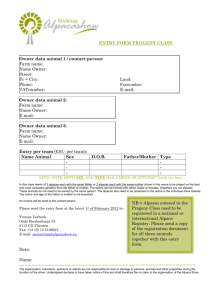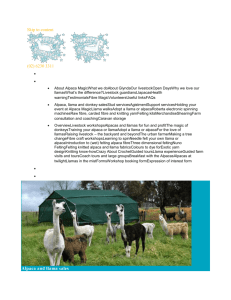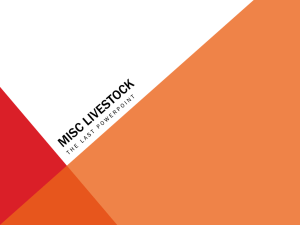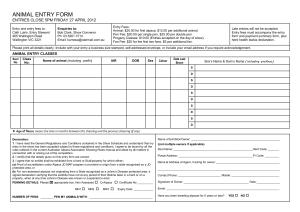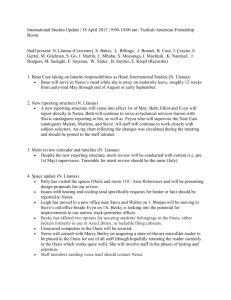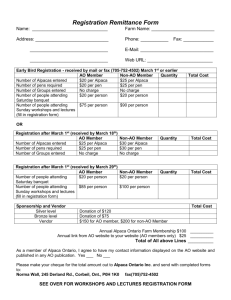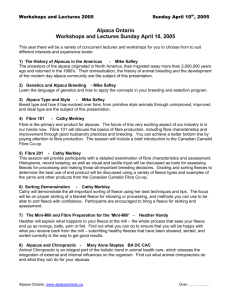Title of activity, Year Level/s and Subject area/s
advertisement
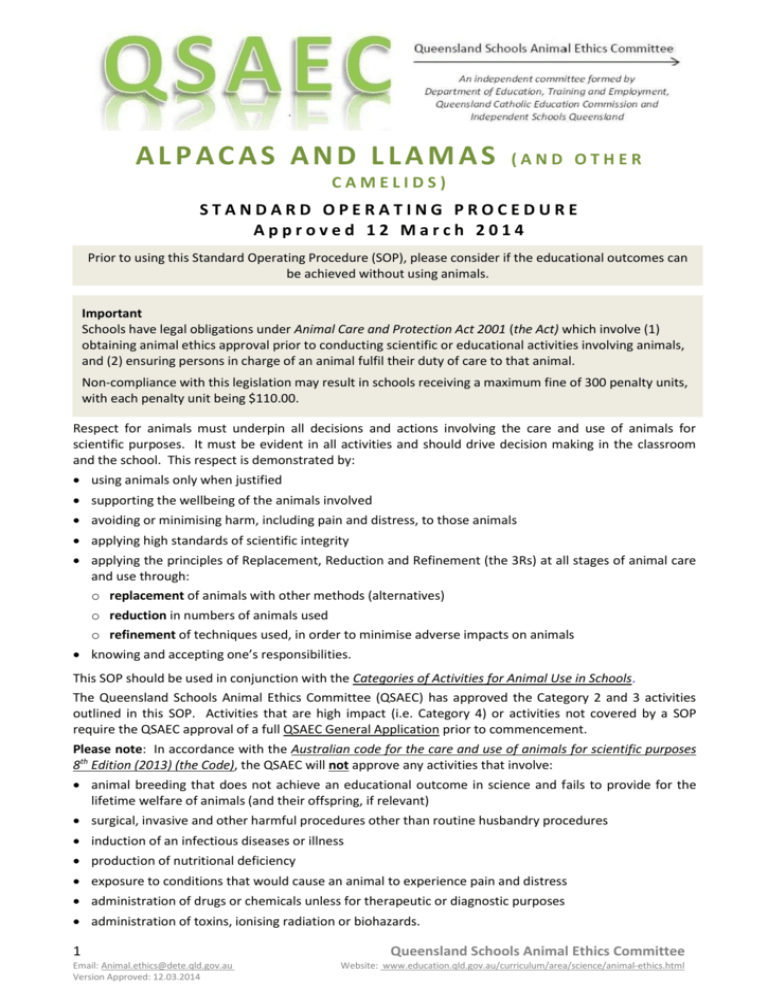
D ALPACAS AND LLAMAS (AND OTHER CAMELIDS) STANDARD OPERATING PROCEDURE Approved 12 March 2014 Prior to using this Standard Operating Procedure (SOP), please consider if the educational outcomes can be achieved without using animals. Important Schools have legal obligations under Animal Care and Protection Act 2001 (the Act) which involve (1) obtaining animal ethics approval prior to conducting scientific or educational activities involving animals, and (2) ensuring persons in charge of an animal fulfil their duty of care to that animal. Non-compliance with this legislation may result in schools receiving a maximum fine of 300 penalty units, with each penalty unit being $110.00. Respect for animals must underpin all decisions and actions involving the care and use of animals for scientific purposes. It must be evident in all activities and should drive decision making in the classroom and the school. This respect is demonstrated by: using animals only when justified supporting the wellbeing of the animals involved avoiding or minimising harm, including pain and distress, to those animals applying high standards of scientific integrity applying the principles of Replacement, Reduction and Refinement (the 3Rs) at all stages of animal care and use through: o replacement of animals with other methods (alternatives) o reduction in numbers of animals used o refinement of techniques used, in order to minimise adverse impacts on animals knowing and accepting one’s responsibilities. This SOP should be used in conjunction with the Categories of Activities for Animal Use in Schools. The Queensland Schools Animal Ethics Committee (QSAEC) has approved the Category 2 and 3 activities outlined in this SOP. Activities that are high impact (i.e. Category 4) or activities not covered by a SOP require the QSAEC approval of a full QSAEC General Application prior to commencement. Please note: In accordance with the Australian code for the care and use of animals for scientific purposes 8th Edition (2013) (the Code), the QSAEC will not approve any activities that involve: animal breeding that does not achieve an educational outcome in science and fails to provide for the lifetime welfare of animals (and their offspring, if relevant) surgical, invasive and other harmful procedures other than routine husbandry procedures induction of an infectious diseases or illness production of nutritional deficiency exposure to conditions that would cause an animal to experience pain and distress administration of drugs or chemicals unless for therapeutic or diagnostic purposes administration of toxins, ionising radiation or biohazards. 1 Email: Animal.ethics@dete.qld.gov.au Version Approved: 12.03.2014 Queensland Schools Animal Ethics Committee Website: www.education.qld.gov.au/curriculum/area/science/animal-ethics.html Pedagogical justification for the use of animals in education It is the teacher’s responsibility to provide a pedagogical justification for any learning activity that involves the use of animals, including activities approved under a SOP. The use of animals must provide an added component to the learning that is not trivial or available in other ways, and there must be evidence to support this position. Planning documents should clearly identify how the use of animals assists in achieving the learning objectives. The justification should consider the impact on the animal/s and must balance whether the potential effects on the wellbeing of the animals involved are justified by the potential benefits. If there are viable alternatives to animal use that meet the learning objectives, they should be used in preference to using an animal/s. At all times the impact on the animal/s should be considered and where suitable discussed with the students in an age-appropriate way. The QSAEC, when undertaking a site visit at the school, may request to see documentation detailing the pedagogical justification for the use of animals. Student and staff health Those involved in the care and use of animals should make themselves aware of the potential disease hazards and other associated occupational health and safety issues, and manage risks according to the school’s risk management process. Apart from injuries which may occur due to handling animals, there are a variety of infectious diseases (zoonoses) that are transmissible from various animals to humans. Zoonotic diseases are common and the illnesses they cause can be serious. They can be spread by direct contact with animals, such as bites or scratches or through indirect contact with animal faeces, bodily fluids, aerosols, birth products, or enclosures contaminated with these materials. Staff should familiarise themselves with the zoonoses the animals in their care may potentially transmit, the routes of transmission of the diseases and what activities may potentially expose staff or students to infection. This research will inform the risk assessment to determine how to manage these risks or determine whether the activity should be conducted at all. For comprehensive advice regarding zoonotic diseases and precautionary measures to minimise risks to staff and students, refer to Handling Live Animals in a School Setting, Infection Control Guidelines for Animal Contact and Preventing Zoonoses. Unexpected Adverse Events An unexpected adverse event is any event that may have a negative impact on the wellbeing of an animal and was not foreshadowed in the approved activity. This can range from the unexpected illness, injury or death of an animal/s to external factors such as facility or equipment failures or inclement weather that may negatively impact on the welfare of the animal. In the event of an unexpected adverse event or emergency, take prompt action to address any adverse impacts on the animal/s and to notify the Animal Ethics Officer of the QSAEC. Alleviating unanticipated pain and distress must take precedence over an individual animal reaching the planned endpoint of the project, or the continuation or completion of the project. Emergency treatment may be required and if necessary, animals must be humanely killed without delay. The QSAEC requires notification of unexpected adverse events within 7 days of the event. In response to an unexpected adverse event, action and investigation by the activity lead or facility manager is required to ensure students, staff or other animals are not inadvertently affected. The specific response will depend on the animal and the circumstances. It may require seeking advice from a veterinarian to determine the best course of action (e.g. necropsy of the dead animal by the vet), removal of the deceased animal (e.g. by the supplier), or diagnostic investigations of facility or management practices to determine cause of death (e.g. water testing of fish tank, inadequate ventilation). Please note: Necropsy of a dead animal is not an approved activity under this SOP due to potential health and biosecurity risks, and must only be performed by a competent person. QSAEC recommends that if a necropsy is required it is performed by a vet. Further advice about reporting unexpected adverse events is available on the Department of Agriculture, Fisheries and Forestry website. 2 Email: Animal.ethics@dete.qld.gov.au Version Approved: 12.03.2014 Queensland Schools Animal Ethics Committee Website: www.education.qld.gov.au/curriculum/area/science/animal-ethics.html Quick Guide Section Category Page 1. General Information 3 2. Qualifications, skills and experience 6 3. Approved Activities 4. 7 7 1. Administering treatments 3 2. Measurement of body weight 2 7 3. Capture, restraint and handling 3 7 4. Ear tagging of livestock 3 8 5. Collection of faeces and urine (non-invasive) 2 8 6. Growth measurement 2 9 7. Milk collection 3 9 8. Pregnancy detection 2 9 9. Measurement of respiration or pulse rate 2 9 10. Handling and taming 3 10 11. Shearing, hoof paring or nail clipping 3 10 12. Measurement of body temperature 3 10 13. Training and grooming for showing 2 11 14. Collection of wool (non-invasive) 2 11 Glossary Activity Notification Form 11 13 SECTION 1 | General information Alpacas and llamas are members of the South American Camelid group of animals. Both animals are domesticated and vary in colour, from white, fawn, brown, roan to grey or black. They are bred as pack animals (llamas only), fibre production, as guardians of other livestock such as sheep, and as pets. Compared to alpacas, llamas are larger, with longer heads, and curved, banana shaped ears. The llama has a straight back and higher tail set compared to the alpaca, which has a rounded sloping rear and a low tail set. Both animals are an environmentally friendly animal with padded feet and a tendency to browse lightly. They are generally easily managed, ‘people friendly’ animals. Baby alpacas and llamas are known as crias. They grow into tuis (adolescents) and then hembras (adult females) and machos (adult males). In Australia, there are two types of alpaca: the Huacaya, which has crimpy fleece, a soft bonnet of fibre on the forehead and sometimes ‘mutton-chops’ on cheeks. The fleece is very fine, soft, lustrous, prickle free and non-allergenic the Suri, which is covered in long, lustrous silken, pencil-fine locks, similar to dreadlocks and has a fringed bonnet. Alpacas and llamas communicate by humming and will spit at each other in order to establish the pecking order within a group especially around meal times. Alpacas and llamas do not spit at people unless they are being abused or feel threatened. They also emit a loud alarm call to alert danger. 3 Email: Animal.ethics@dete.qld.gov.au Version Approved: 12.03.2014 Queensland Schools Animal Ethics Committee Website: www.education.qld.gov.au/curriculum/area/science/animal-ethics.html Physical attributes Alpacas Size 78-104cm at the withers Weight 47-80kg Age at adult size 2-3 years Average life span 15-20 years Life expectancy 20-25 years Gestation Period 11½ months, range 11-12 months Weight at birth 6-8kg Number of offspring 1 (twinning is extremely rare) Weaning Age 6-8 months Healthy characteristics Body temperature:36.4˚C-37.8˚C Heart rate: 60-100 beats/minute Respiration rate: 20-30 breaths/minute. Range of breeding ages Females: 12-14 months, Males: 1½ –2 years Llamas Size 1.7 -1.8 m Weight 130 – 200kg Age at adult size 3 years Average life span 20-30 years Gestation period 11 ½ months Weight at birth 9-14kg Number of offspring 1 (twinning is extremely rare) Weaning 5-6 months Healthy characteristics Body temperature: 38.1˚C - 39.9˚C Heart rate: 60-90 beats/min Respiration rate: 20-30 breaths/min Environment Movement and Exercise: Alpacas and llamas need space to run and room for a dust bath. Access to shade and feed/water throughout the day is essential and sprinklers may be provided on very hot days to allow the animals to cool down. Alpacas and llamas prefer shelters that allow them to see their external surroundings. Fencing: 1.2 metre high sheep fencing is adequate for alpacas and llamas. Do not use barbed wire where the animals may come into contact with it. Alpacas and llamas rarely test fences however, if they are confined and stressed, they will easily jump over 1m high pens, particularly if they are confined without companions. For this reason, it is always advisable to take a pair of animals to shows and displays. All fencing must provide adequate protection from predators. Temperature and/ temperature control: Alpacas and llamas can survive harsh conditions but are susceptible to heat stress. They should be provided with access to shade, feed/water and sprinklers in very hot weather. Shear alpacas each year around September or October. They rarely seek shelter from rain but usually lie down with their legs tucked underneath them. Crias and freshly shorn alpacas and llamas need protection from the cold. A simple three sided shelter is often all that is needed for protection. Bedding: Due to the problems of fleece contamination, bedding for penned animals should be made from rubber, woven or slatted matting rather than straw. If straw is used, ensure that it is free from seed as seed is difficult to remove from the fleece. Cleaning: Alpacas and llamas avoid defecating in their pens unless confined for long periods. They usually wait until they can reach a communal dung pile, which is an area designated by the animals where they urinate and defecate. There are usually several dung piles within any one field. 4 Email: Animal.ethics@dete.qld.gov.au TRIM 12/383689 Version Approved: 12.03.2014 Queensland Schools Animal Ethics Committee Website: www.education.qld.gov.au/curriculum/area/science/animal-ethics.html Food and water requirements It is very important not to change the diet of an alpaca and llama quickly as this can lead to death. The diet needs to be changed gradually. Often farmer’s animals are mostly grazing whereas schools’ animals are fed using processed feed and long stemmed hay. Although slightly heavier than sheep, alpacas and llamas are more efficient feed converters, so require a similar amount of feed. A maintenance diet for alpacas and llamas is about 1.5% of their body weight each day on a dry weight basis. The additional energy and nutrient requirements of a lactating alpaca or llama increases the daily requirement to 3-4% of their body weight. Supplementary feeding may be necessary if insufficient grazing is available on pastures. Alpacas and llamas can have their diets supplemented with a stud mix, lucerne hay or alpaca/llama pellets and chaff. It is not advisable to feed grain to alpacas. Seek advice from the Queensland Department of Agriculture, Fisheries and Forestry (DAFF) for correct feeding, pasture quality and supplementation. Alpacas and llamas must have access to fresh, clean drinking water at all times. Handling Alpacas and llamas need to be handled calmly and with care to prevent distress and injury to the animals and their handlers. When working with these animals, quiet and slow behaviour makes them easy to handle and they usually herd easily. Alpacas and llamas learn quickly and will learn to come up to a feeding pen when called. Normal behaviour Alpacas and llamas are herd animals and need the company of others. A minimum of two animals should be kept. Intact males should be kept with a companion separate to female alpacas. Alpacas and llamas are normally alert and inquisitive and move together when herded. They groom themselves by having regular dust baths and scratching on posts or bushes. The herd will have a community dung pile and if necessary, will even line up and wait their turn. Alpacas and llamas chew their cud, usually while lying down in the early morning. They will sprawl out and sun themselves, especially after periods of rain and will wade in creeks, dams or even water troughs to cool down. Alpacas and llamas can swim. Disease prevention Disease control methods and internal and external parasite control programs should be developed in consultation with a veterinarian or DAFF officer. All actions should be documented in the appropriate records. Signs of illness Alpaca’s and llama’s health should be monitored daily or even more often. One of the first signs of illness is a change in their natural demeanour. They may be listless or lethargic and a closer examination may show variations in: body temperature gastrointestinal function, e.g. diarrhoea, constipation, weight loss, loss or change of appetite lack of regular dust bathing habits or bathing in unusual places urogenital function such as abortion, infertility or abnormal discharges respiratory function, e.g. nasal flaring, persistent coughing, gasping or panting. There may be evidence of: skin conditions, such as hair loss, patchy coat, lesions or abnormal growths stiff gait or abnormal posture cushing (ie. sitting in an upright resting position with all legs tucked under) more often, easily approached excessive scratching or rubbing swollen joints or lameness watery eyes, holding eyes shut. A failure to thrive or grow is another sign of illness. If unable to identify and correct the cause of ill health, assistance from a veterinarian familiar with alpacas/llamas should be sought. Any signs of illness or injury, and treatments given, must be documented in the appropriate records. 5 Email: Animal.ethics@dete.qld.gov.au Version Approved: 12.03.2014 Queensland Schools Animal Ethics Committee Website: www.education.qld.gov.au/curriculum/area/science/animal-ethics.html Q fever Q fever is a highly infectious bacterial infection which may be acquired from camelids. Animals cannot be vaccinated against Q fever. Infected animals show no signs of illness but shed the bacteria into their environment through urine, faeces, milk and birth tissues and fluids. Pregnant and birthing animals present a high risk as birth tissues and fluids can have particularly high concentrations of Q fever bacteria. Q fever is mainly spread by inhalation of bacteria particles from infected animal body fluids, either directly or attached to dust particles. Contaminated dust becomes airborne through dusty stockyards and prevailing winds, animal movement, dry sweeping, handling wool, hides, straw/hay and manure etc. Q fever bacteria can also become airborne directly during animal birthing, handling birth products, high pressure hosing, slaughtering animals and dressing carcasses. Less commonly, Q fever can be spread through drinking unpasteurised milk. Humans can gain immunity to Q fever through previous exposure or vaccination. Vaccination is licenced for those aged 15 years or older. Q fever can be a very serious disease and prevention is a priority. Higher risk activities that should be avoided by nonimmune staff and students include those that expose staff and students to dust and aerosols, e.g. observing or assisting with animal birthing handling birth products slaughtering animals and dressing the carcass generating dust and aerosols when cleaning up birth products and animal excreta (e.g. dry sweeping, using a high pressure hose) visiting at-risk workplaces (e.g. abattoirs, tanneries). Refer to the Q fever in the School Environment fact sheet for comprehensive advice and precautionary measures to take when conducting the Approved Activities described below. Euthanasia Where animals are so sick, diseased or injured that recovery is unlikely or undesirable on humane grounds, then euthanasia must be arranged with a local veterinarian or a person competent in the technique for alpacas or llamas. Disposal Alpacas and llamas can be sold privately or at auction. Carcasses must be disposed of in accordance with local council regulations. Animal emergency arrangements The school must have an emergency management plan to deal with events in and out of school hours. Details of the plan will vary according to the needs of each school and must include: monitoring of animals, including weekends and school holidays a first aid kit for animals at least one local veterinarian on call a list of who is competent to euthanase animals if necessary (this is likely to be the local veterinarian but may also be an Agricultural Science HOD / TIC or Agricultural Assistant) a schedule of persons authorised to respond to emergencies and engage veterinary assistance. SECTION 2 | Qualifications, skills and experience Any teacher conducting scientific animal activity must have: relevant science or science education qualification (e.g. Agricultural Science, Biological Science), or relevant science or science education experience as deemed appropriate by the school principal (generally 2 years’ experience) and competency in the particular procedure. For new or inexperienced teachers (less than two years’ experience), all activities must be conducted under the supervision of a Science or Agricultural Science Head of Department (HOD) or suitably experienced person. Where direct supervision by a suitably experienced person is not available, a new or inexperienced teacher must: identify a mentor, who may be a Science or Agriculture HOD from a neighbouring school, and provide planning documents to mentor. 6 Email: Animal.ethics@dete.qld.gov.au Version Approved: 12.03.2014 Queensland Schools Animal Ethics Committee Website: www.education.qld.gov.au/curriculum/area/science/animal-ethics.html Persons deemed to be suitably qualified will have: conducted risk assessments on the procedure/s to be carried out found the procedure/s to be safe and humane considering animal and student welfare considered the maturity and suitability of the student/s involved in the activity. Teachers should ensure that animal users, including students and visitors, are provided with adequate prior instruction in specific activities to enable appropriate care of an animal and to minimise risk of undue stress or harm to an animal. SECTION 3 | Approved Activities 1. Administering treatments Category 3 – moderate impact Activity Objective Administration of oral drench and subcutaneous injections To instruct students in the procedures for the administration oral and subcutaneous treatments Alternatives Ratios References Use of videos and role plays is encouraged Instructors : Students 1:30 instructing 1:1 supervising Students : Animals 30:1 observing 2:1 performing Oral – drench: Most school alpacas and llamas will be with other livestock and therefore, will need to be drenched routinely at the same time as the other livestock. The dose will depend on the weight of the animal. Ensure the dose is calculated accurately. Restrain the animal securely and place the nozzle of the gun on top of the back of the tongue. Hold the animal’s head upwards until it has swallowed the drench. As there are no approved drenches for alpacas, seek advice from the local vet to determine appropriate products. Injection – subcutaneous: Alpacas and llamas should be vaccinated six monthly using either 5-in-1 or 7-in-1 vaccine. First vaccinations should occur at one month of age and a booster given one month later. Injection should be subcutaneous and placed behind the elbow or on the shoulder. It is important to maintain a program of vaccination and control of parasites. Faecal testing is recommended to determine if and what types of internal parasites are to be treated. When treating for internal and external parasites, all animals should be treated at the same time and pastures should be rotated in conjunction with the drench program. These activities need to be documented in the appropriate records. When using vaccines, drenches or any other animal care chemicals, the manufacturer’s instructions must be followed and care must be taken and noted about the following: 2. check the MSDS and product information data to determine if suitable, e.g. for type of worms encountered, suitable for age and for pregnancy status maintaining appropriate storage adhering to withholding periods determining the weight of animals determining the correct dose rate using protective clothing if required. Measurement of body weight Category 2 – low impact Activity Objective Alternatives Measurement of body weight Video, learning guides or booklets are encouraged Ratios References Instructors : Students 1:30 instructing 1:1 supervising Students : Animals 30:1 observing 2:1 performing Alpacas and llamas that are handled regularly can be easily trained to stand quietly on livestock scales. 3. To instruct students in the measurement of body weight Capture, restraint and handling Category 3 – moderate impact Activity Objective 7 Email: Animal.ethics@dete.qld.gov.au Version Approved: 12.03.2014 Alternatives Ratios References Queensland Schools Animal Ethics Committee Website: www.education.qld.gov.au/curriculum/area/science/animal-ethics.html Capture, restraint and handling To instruct students in methods of capturing for human handling in yard facilities; to lead, tie up and stand in show setting. Video presentation and learning guides can assist and are encouraged. Instructors : Students 1:30 instructing 1:1 supervising Students : Animals 30:1 observing 2:1 performing Where possible, it is recommended that the alpacas and llamas be herded into a smaller enclosure or their usual handling area, where they are more comfortable and settled, before handling the animals. Isolating an animal is best performed by slowly confining the herd into increasingly smaller numbers. One method of confining the herd is to use a moveable fence, working in a quiet, calm manner. A moveable fence can be established by having a long rope held at waist height between two people and stretched across a paddock. This enables the alpacas and llamas to be herded to a particular location. Capture is easiest with the handler’s arm high up around the animal’s neck. Most alpacas and llamas will be quite comfortable in this position while a halter is fitted. Before students attempt these tasks, they should be familiar with alpaca and llama behaviour and be instructed to move quietly and slowly. Haltering can be dangerous for alpacas and llamas; if fitted incorrectly or ill-sized the halter could collapse the nasal passage and prevent the animal from breathing. Properly sized halters should be used and should be fitted such that they cannot slide down onto the cartilage of the nose and compress the nasal passage. Halters should not be left on the animal when not in use. Alpacas and llamas can be restrained by holding the animal’s head and neck firmly to the handler’s chest while the other hand rests over the animal’s withers. If necessary, another person may be used to pin the back end of the animal firmly to the side of a pen. Take care that the animal is not able to get its legs caught in fencing. The rear legs can be lifted and the feet placed into the loop of soft rope under the abdomen. If it is necessary to lay the animal down, use two people standing on one side of the animal. Both lean across the animal’s back and grasp the legs closest to the handlers. Carefully flip the animal over with the front handler also supporting the neck. 4. Ear tagging of livestock Category 3 – moderate impact Activity Objective Alternatives Ratios Ear tagging To demonstrate ear identification used to identify individual animals in a herd situation Video, learning guides or booklets and role plays using cardboard or similar material is encouraged Instructors : Students References 1:30 instructing 1:1 supervising Students : Animals 30:1 observing 1:1 performing Registered alpacas and llamas have a brass ear tag that is placed on the left ear for a male and on the right ear for a female. Plastic numbered tags may be used in the opposite ear. The animal should be carefully restrained while the ear is cleaned. Applicators and tags should be smooth, sharp and thoroughly cleaned. Ensure that the tag does not puncture the veins. NLIS tags will be introduced at a future date and must be applied according to instructions from the Department of Agriculture, Fisheries and Forestry. 5. Collection of faeces and urine (non-invasive) Category 2 – low impact Activity Objective Collection of faeces and urine samples To demonstrate the process of collection of faeces and urine samples Alternatives Ratios References Video, learning guides or booklets are encouraged Instructors : Students 1:30 instructing 1:1 supervising Students : Animals 30:1 observing 30:1 performing Faeces can be easily collected from a communal dung pile. To collect faeces from a particular animal, clean up the dung pile and place a large cloth or feed bag over the dung pile. The animal will defecate on top of, or very close to it. Staff and students should wear gloves and follow proper hygiene procedures. Collection of urine would rarely need to be carried out. If it is deemed necessary, a bucket placed over the dung pile or container on long pole may be a useful technique to collect the sample. Ensure that staff and students wear gloves and follow strict hygiene procedures. N.B. The collection of camelid excreta is a high risk activity for staff and students who are not immune to Q fever. 6. Growth measurement 8 Email: Animal.ethics@dete.qld.gov.au Version Approved: 12.03.2014 Queensland Schools Animal Ethics Committee Website: www.education.qld.gov.au/curriculum/area/science/animal-ethics.html Category 2 – low impact Activity Objective Alternatives Ratios Growth measurement To instruct in methods of measuring growth, including wool growth Video, learning guides or booklets are encouraged Instructors : Students References 1:30 instructing 1:2 supervising Students : Animals 30:1 observing 2:1 performing The animal’s growth can be followed by measuring the height of the animal at the withers. Wool growth can be measured by using a ruler to take a series of random measurements on different sections of the animal’s fleece. Students can compare growth rate of the different sections. While the quality of the saddle and neck fleece may often be similar, it is the different growth rates that necessitate its separation during classing. After shearing, wool can be sent off for fibre diameter analysis. This process is quite cheap and provides an excellent resource for students. 7. Milk collection Category 3 – moderate impact Activity Objective Alternatives Ratios References Milking To demonstrate to Video, learning guides Instructors : Students students the procedure or booklets are 1:30 instructing of collecting milk, if a encouraged Students : Animals newborn cria requires 30:1 observing hand feeding This procedure should only be carried out if a weak, newborn cria needs hand feeding. To obtain the milk, cut the end of a 20mL disposable syringe and remove the plunger. Insert the plunger through the cut off end as far as it will go. Using a little milk to create a good seal, place the un-cut end of the syringe over the teat and, very slowly, pull the inside plunger downwards. It is important to maintain strict hygiene procedures throughout. Follow the instructions for the bottle feeding method to avoid aspiration. 8. Pregnancy detection Category 2 – low impact Activity Objective Alternatives Ratios Pregnancy detection To demonstrate ultrasonography to students to confirm pregnancy Video, learning guides or booklets are encouraged Instructors : Students References 1:30 instructing Students : Animals 30:1 observing Initial diagnosis of pregnancy is made by parading the female in front of a potent male. If she ‘spits him off’ (spits in his direction), it indicates a lack of interest and refusal to breed, which may indicate pregnancy. Pregnancy can be confirmed after 15 days by ultrasonography (commonly referred to as ultrasound). Due to a high rate of early embryonic mortality, i.e. 30-35% in the first 40 days, it is best to delay ultrasonography until after 40 days. Repeat the spit offs and ultrasonography at 120 days. 9. Measurement of respiration or pulse rate Category 2 – low impact Activity Objective Alternatives Ratios Measurement of respiration and pulse rate To instruct students in the measurement of respiration and pulse rate Video, learning guides or booklets are encouraged Instructors : Students References 1:30 instructing 1:1 supervising Students : Animals 30:1 observing 2:1 performing Respiration can easily be measured by holding a hand close, without touching, to the animal’s nostrils to feel the breath. 9 Email: Animal.ethics@dete.qld.gov.au Version Approved: 12.03.2014 Queensland Schools Animal Ethics Committee Website: www.education.qld.gov.au/curriculum/area/science/animal-ethics.html The pulse can be recorded by feeling the animal’s carotid artery at the base of the jaw. With a little practice, students should be able to hear the pulse rate using a stethoscope. It is best if students practise using a stethoscope on each other prior to performing this procedure. 10. Handling and taming Category 3 – moderate impact Activity Objective Handling and taming Alternatives To instruct students in methods of training for human handling in yard facilities; to lead, halter and tame Ratios References Video presentation and learning guides can assist and are encouraged. Instructors : Students 1:30 instructing 1:1 supervising Students : Animals 30:1 observing 2:1 performing All alpacas and llamas to be used at schools should be tamed as early as possible to avoid stress on the animals when students handle them. Young animals at 6-8 months that have just been weaned are easy to tame. Older animals that have been handled extensively and are well tamed will be the most suitable to purchase for the school environment. Older, untamed animals may never settle in and are likely to become stressed when handled extensively by students. Even when there is adequate pasture, animals can be given a small amount of hand feeding each day to help the taming process. Alpacas and llamas respond to calm and gentle handling and usually prefer not to be touched on the head. 11. Shearing, hoof paring or nail clipping Category 3 – moderate impact Activity Objective Alternatives Ratios Shearing, hoof paring or nail clipping To demonstrate to students the procedure shearing, hoof paring or nail clipping Video, learning guides or booklets are encouraged Instructors : Students References 1:30 instructing Students : Animals 30:1 observing These procedures are best carried out by an experienced shearer or handler. Alpacas and llamas are restrained by being stretched out on the floor or shearing table and having their legs tied to wooden spacers. A handler holds the head of the animal. When one side of the animal has been shorn, the animal is flipped over and the other side is done. It is important to have the fleece as clean as possible before shearing and students can pick off debris and blow out dust. Place a large tarpaulin on the ground to lay the animal on during shearing. Students can class and separate the fleece after shearing and maintain the shearing area. NB. Blowing dust out of fleece is a high risk activity for staff and students who are not immune to Q fever. Alpacas and llamas nails will need regular checking and must be clipped if required. This can be done by an experienced person using standard hoof paring or footrot shears http://www.alpaca.asn.au/docs/about/info/10toenails.pdf. Male alpacas should have their fighting teeth checked and trimmed by an experienced handler or vet if necessary using diamond wire or dremel to avoid injury to other animals and handlers. 12. Measurement of body temperature Category 3 – moderate impact Activity Objective Alternatives Ratios Measurement of body temperature To instruct students in the measurement of the body temperature Video, learning guides or booklets are encouraged Instructors : Students References 1:30 instructing 1:1 supervising Students : Animals 30:1 observing 1:1 performing Temperature is measured rectally using a clinical thermometer. Ensure that the animal is carefully restrained and use a plastic digital thermometer dipped in lubricant to prevent injury from a broken glass thermometer. Ensure students wear gloves and follow appropriate hygiene procedures. 10 Email: Animal.ethics@dete.qld.gov.au Version Approved: 12.03.2014 Queensland Schools Animal Ethics Committee Website: www.education.qld.gov.au/curriculum/area/science/animal-ethics.html 13. Training and grooming for showing Category 2 – low impact Activity Objective Alternatives Ratios Alpaca grooming To instruct in methods of preparation of alpaca showing, including grooming, washing, combing, clipping and halter training Video, learning guides or booklets are encouraged Instructors : Students References 1:30 instructing 1:10 supervising Students : Animals 30:1 observing 2:1 performing All school alpacas and llamas should be halter trained. To do this, the handler needs to hold an animal firmly and use a reassuring voice. With a lead attached to the halter, the handler stands in front, faces the alpaca and pulls the animal gently forward. As soon as the animal takes a step forward, the tension on the lead is loosened. Continue this process until the animal walks with the handler. The alpaca or llama can then be taught to walk beside the handler. With young alpacas and llamas that are happy to be handled, it may be easier for the handler to walk beside the animal with one hand holding the lead. A young alpaca/llama will frequently follow a companion who has already been halter trained, making the job much easier. If animals are to be shown, they need to become used to grooming. Grooming consists of picking debris off the fleece and lightly blowing the dirt/dust out of the fleece using the blower end of a vacuum cleaner or a cattle blower. Most shows have classes for alpaca/llama wethers (castrated males) and fleeces. NB. Blowing dirt/dust out of fleece is a high risk activity for staff and students who are not immune to Q fever. 14. Collection of wool (non-invasive) Category 2 – low impact Activity Objective Alternatives Ratios Collection of wool samples To instruct students in the procedures for the collection of wool samples Video, learning guides or booklets are encouraged Instructors : Students References 1:30 instructing 1:30 supervising Students : Animals 30:1 observing 30:1 performing If a small sample is required, scissors can be used to cut a sample as close to the skin as is safely possible. Ensure that the animal is restrained securely. SECTION 4 | Glossary Ratios Instructor/student and student/animal ratios stated in this document are minimum requirements Supervision Supervision in all instances means supervision by a suitably qualified person familiar with the procedures as well as normal and abnormal animal responses MSDS Materials Safety Data Sheet NILS National Livestock Register Identification Scheme QSAEC Queensland Schools Animal Ethics Committee ‘the Act’ Animal Care and Protection Act 2001 ‘the Code’ Australian code for the care and use of animals for scientific purposes, 8th Edition, 2013 Alternatives to animal use Replacement of animals with other methods/activities for educative purposes must be sought and used whenever possible Unexpected adverse event An event that may have a negative impact on the wellbeing of animals and was not foreshadowed in the approved proposal, SOP or subsequent documents to the QSAEC. An unexpected adverse event may result from different causes, including but not limited to: • death of an animal, or group of animals, that was not expected (e.g. during surgery or anaesthesia, or after a procedure or treatment) • adverse effects following a procedure or treatment that were not expected • adverse effects in a larger number of animals than predicted during the planning of the project or activity, based on the number of animals actually used, not the number approved 11 Email: Animal.ethics@dete.qld.gov.au Version Approved: 12.03.2014 Queensland Schools Animal Ethics Committee Website: www.education.qld.gov.au/curriculum/area/science/animal-ethics.html for the study • a greater level of pain or distress than was predicted during the planning of the project or activity • power failures, inclement weather, emergency situations or other factors external to the project or activity that have a negative impact on the welfare of the animals. 12 Email: Animal.ethics@dete.qld.gov.au Version Approved: 12.03.2014 Queensland Schools Animal Ethics Committee Website: www.education.qld.gov.au/curriculum/area/science/animal-ethics.html CAMELIDS (INCLUDING ALPACAS AND LLAMAS) Standard Operating Procedure - approved 12 March 2014 ACTIVITY NOTIFICATION FORM I, acknowledge that I am the teacher appointed/authorised teacher representative who will conduct this animal use activity. Title of activity, Year Level/s and Subject area/s: School/School Authority name Description of school group Scientific User Registration Number (Each school entity that uses animals must register with The Department of Agriculture, Fisheries and Forestry (DAFF) before any animal use activities are undertaken. EQ QCEC (All EQ schools use this number) 102 Species of animal You must have a DAFF number here: ISQ You must have a DAFF number here: Other: You must have a DAFF number here: Number of animals In that capacity I agree that: have read and understood Responsibilities of School Personnel under the Code adequate resources will be available to undertake the project I and all others involved are familiar, and will comply, with the Animal Care and Protection Act 2001 (Qld) and the Australian Code for the Care and Use of Animals for Scientific Purposes 2013 no animal will be used in this activity except as described in this SOP and Activity Notification form health risks and infection controls have been considered and assessed all staff members and students involved in animal use activities are competent to perform the necessary tasks with care and knowledge of their ethical and legal responsibilities and the conditions imposed by the SOP. I agree that I have considered the 3Rs of animal welfare: replacement of animals with other methods (alternatives) reduction in numbers of animals used refinement of techniques used, in order to reduce adverse impacts on animals. Activity Leader Name: Signature: Activity Leader email: Activity Leader phone number: Approval granted by QSAEC is on the condition that the following actions are taken. Please indicate acceptance by checking the boxes below. The Principal has: Principal Name: read and approved this application Signature: signed a hard copy of this application Date: ensured a hard copy of this application will be held for 7 years for audit purposes. Once approved, activity details should be entered into the appropriate school records by administrative staff. All fields must be complete before lodging this Activity Nomination Form. To lodge this form, email this page only to AnimalEthics.APPLICATIONS@dete.qld.gov.au, alternatively you can fax this page to (07) 3237 0101. If you are emailing the Activity Nomination form ensure that you keep the signed hardcopy on file at the school for auditing purposes. 13 Email: Animal.ethics@dete.qld.gov.au TRIM 12/383689 Version Approved: 12.03.2014 Queensland Schools Animal Ethics Committee Website: www.education.qld.gov.au/curriculum/area/science/animal-ethics.html
